December 8, 2006
Air Date: December 8, 2006
FULL SHOW
SEGMENTS
AN INCONVENIENT CONTROVERSY
View the page for this story
The National Science Teachers Association, made up of 53,000 educators, declined an offer of 50,000 free DVD copies of Al Gore’s film on global warming, "An Inconvenient Truth." NSTA Director Dr. Gerry Wheeler says the organization doesn't distribute third party materials, but environmentalist Laurie David, who produced the film, sees something more sinister at play. Host Bruce Gellerman hears from both sides of the science education debate. (12:00)
Biomimicry - Lessons from Mother Nature
/ Andrea KissackView the page for this story
A growing number of scientists, engineers, and architects work on the assumption that most design problems have their solutions somewhere in nature - if we can only find the right microbe, beetle or flower. KQED’s Andrea Kissack reports on the concept, and limitations, of biomimicry. (06:00)
Just Say No to Cerulean Warbler
View the page for this story
Is coal mining pushing the forest-dwelling songbird, the Cerulean Warbler, to the brink? Some conservationists think so and they’ve petitioned the government to have the bird protected under the Endangered Species Act. The National Audubon Society’s director of bird conservation Greg Butcher joins host Bruce Gellerman to discuss the government’s recent decision regarding the fate of this little, blue bird. (05:15)
Winged Rats or Wronged Warriors?
View the page for this story
Living on Earth drops in on pigeons, for a change. Author Andrew Blechman joins host Bruce Gellerman to discuss why this once-lauded war hero has been pigeon-holed as a public enemy. (06:50)
Inventor Interrupted
/ Harry GoldsteinView the page for this story
Harry Goldstein of IEEE Spectrum Radio offers a reporter’s notebook on Corliss Orville Burandt, a man who claims to have invented the device that makes hybrid auto engines work. But Burandt lost his job, his home, his family and his mind when the patent slipped out of his hands and into the public domain. (13:45)
Season of Light
View the page for this story
A preview of Living on Earth’s annual holiday storytelling special. This year, we hear tales of light and darkness from around the world. (02:15)
This week's EarthEar selection
listen /
download
An afternoon by Pichola Lake in Udaipur, India.
Show Credits and Funders
Show Transcript
HOST: Bruce Gellerman
GUEST: Andrew Blechman, Greg Butcher, Heidi Dahlsveen, Laurie David, Dr. Jared Wheeler
REPORTER: Harry Goldstein, Andrea Kissick
[THEME]
GELLERMAN: From Public Radio International - this is Living on Earth.
[THEME]
GELLERMAN: I’m Bruce Gellerman. The world’s largest science education organization says “no” to an offer of free copies of the global warming film “An Inconvenient Truth.”
WHEELER: The National Science Teachers Association does not endorse any materials produced by any group outside of NSTA.
GELLERMAN: But the producer of the film says that’s just a convenient cop-out.
DAVID: This is less about a DVD and more about the fact that school science seems to be up for sale here.
GELLERMAN: An inconvenient controversy over science education. And, pigeons - once thought of as heroes on the battlefield, now just, well, pigeons.
BLECHMAN: For ten thousand years, pigeons were considered our very best friends and just in about the last fifty years, they’ve just been utterly vilified as vermin by the pest control industry.
GELLERMAN: We drop in on pigeons and more, this week on Living on Earth. Stick around!
[NPR NEWSCAST]
ANNOUNCER: Support for Living on Earth comes from the National Science Foundation and Stonyfield Farm.
[THEME]
AN INCONVENIENT CONTROVERSY
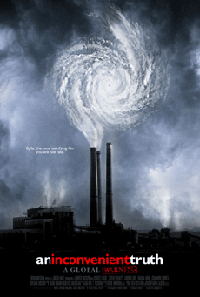
(Courtesy of Climatecrisis.net)
GELLERMAN: From the Jennifer and Ted Stanley Studios in Somerville, Massachusetts - this is Living on Earth. I’m Bruce Gellerman.
[MUSIC FROM MOVIE]
GELLERMAN: The film, “An Inconvenient Truth” is the third largest grossing documentary of all time right behind “Fahrenheit 911” and “March of the Penguins.”
The movie, featuring former Vice President Al Gore, warns that we’re sitting on a ticking time bomb that scientists believe we have just 10 years to prevent global warming and planetary disaster.
GORE: It’s our only home, and that is what’s stake: our ability to live on planet earth, to have a future as a civilization.
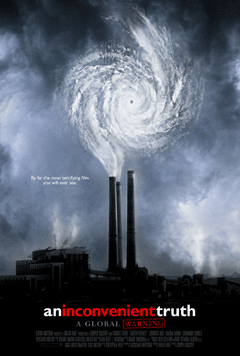
(Courtesy of Climatecrisis.net)
Recently, Laurie David, executive producer of the film, offered free copies of “An Inconvenient Truth” to the science teachers association but it refused her offer. Laurie David wrote a scalding Op-Ed piece in the Washington Post criticizing the group and she joins me on the line. Hi, Ms. David.
DAVID: Hi how are you?
GELLERMAN: I’m fine, thank you very much. You know you offered 50,000 free copies of the DVD “An Inconvenient Truth” to the National Science Teachers Association. What were you hoping to accomplish?
DAVID: Well, what I was hoping to accomplish is to get this movie, “An Inconvenient Truth”, which is you know the definitive story about how the globe is warming and that humans are causing it into schools so school kids can see the truth about what’s happening with this issue.

Laurie David, executive producer of “An Inconvenient Truth” (Courtesy of LaurieDavid.com)
DAVID: Well, I was quite shocked actually. You know we had a series of e-mail exchanges with NSTA and they seemed very interested at first and we went back and forth and the next thing we know they said no thank you. And I have to tell you I have been deluged with e-mails from teachers all over the country, every single state in the country saying this is outrageous. I mean they are running 99 to 1 outraged at the fact that the NSTA did not accept these free DVDs.
GELLERMAN: And you wrote about this in the Op-Ed column in the Washington Post.
DAVID: Right it ran in the Washington Post and I just could not believe the response from teachers. And by the way from other associations who are e-mailing us saying, well we’ll help you distribute this and people really are not understanding why wouldn’t NSTA accept this? And I said in the op-ed, I think, there’s one reason and it has to do with the oil industry, that they accept money from Exxon-Mobile. Exxon-Mobile has spent millions of dollars over the last decade trying to confuse the public on global warming. And now they’re infiltrating our schools. I mean really, this less about a DVD and more about the fact that school science seems to be up for sale here.
GELLERMAN: Well, I spoke with Dr. Jared Wheeler who is the executive director of the National Science Foundation. He says he just saw the film just a few days ago.
DAVID: That says something doesn’t it? I mean this guy is the head of the NSTA and he just saw the film a couple days ago. It’s been out for months. I don’t understand that right there.
GELLERMAN: Well, let’s listen to my conversation with Dr. Wheeler about the film and the controversy.
WHEELER: I thought it’s a compelling story. I’ve seen Vice President Gore give this talk a number of times fifteen years ago and he tells a compelling story.
GELLERMAN: Why did you turn it down when they were giving you an offer of 50,000 free copies of it?
WHEELER: The reason we turned it down is because of our endorsement policy or our non-endorsement policy. The National Science Teachers Association does not endorse any materials produced by any group outside of NSTA.
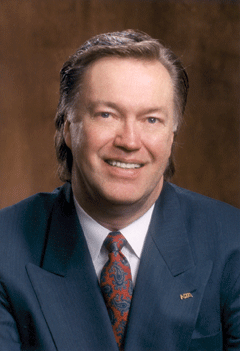
Dr. Gerald Wheeler is the executive director of the National Science Teacher’s Association.(Courtesy of NSTA)
WHEELER: Ah, no actually we didn’t. We didn’t mass distribute those. And the difference between that, Bruce is that it wasn’t a Conoco-Phillips production it was a National Teachers Association Production. Conoco-Phillips came to me in 2001 and said they’d like to have us reproduce or recreate their classic Search for Solutions.
I’ve identified the research scientists, the science educators, convened an advisory group. I chaired it. The advisory group chose the content, chose the sites to visit, passed on all the rough cuts and passed on the final production. So it’s an NSTA project. Phillips, it was just Phillips at the time, but Conoco-Phillips now, Phillips paid for the production, but it was entirely an NSTA production.
GELLERMAN: Well, I’m looking at an episode right now and it raises quite a lot of uncertainties. One of the lines in this is really eye opening. It says quote, “Some scientists believe that the high level of present day CO2 will soon be, if not already, on the decrease” end quote. It suggests that there’s an entirely different body of science there that says we don’t have any problems. It’s going to get better.
WHEELER: And it was correct in 2001 that some scientists did say that. It is not a biased production. It is trying to get children to look for evidence and to have discussions, honest discussions in their classrooms with their science teachers and sort of, if you will, unpack the nature of science.
GELLERMAN: Is it still available?
WHEELER: Yes it is.
GELLERMAN: But I could get a copy of this if I wanted to. Because when I went to your site I can’t get a copy. But when I go to a site that’s linked to Conoco-Phillips I can.
WHEELER: Right they actually own the DVD and they are the ones that distribute it, not us.
GELLERMAN: You currently receive funding from the Exxon-Mobile corporation which has a
WHEELER: That is correct.
GELLERMAN: They have a person that sits on your corporate advisory board.
WHEELER: No, it’s our corporate advisory group. It’s a group that just advises me on the logistics of running operations. I’m a physicist and our organization is composed completely of science teachers. So I joined NSTA, when I joined NSTA I thought we need to get a lot smarter about how we run our business, how to run our IT group, how to run our e-commerce as the internet group.
So, I asked about eight industrial leaders to sit with me twice a year on my senior staff to talk about issues, business issues. And half, not half, well almost half of them are projects that we’re currently running and half are not. Some haven’t given us any money at all. And some have given us some money for a breakfast at a conference. And some have been major partners like Exxon-Mobile in that network that we have.
GELLERMAN: Well, one of your critics says that you have corporate propaganda masquerading as environmental education. That’s a serious charge.
WHEELER: Sure. It is a serious charge and we take it very seriously. But I think where that’s coming from, Bruce; but I can’t get into the mind of this person. But I think where that’s coming from is at our conferences a variety of organizations, and corporations rent space, rent exhibit space. We say yes to that because we want science teachers to have the opportunity to go up to these people and talk to them and decide for themselves what works for their classroom, their students, their community and their state science standards. I don’t judge that message. I’m only careful that in fact NSTA is not seen as giving that message. We are providing the information. It is the science teacher who is the professional who has to decide if it works for him or her.
GELLERMAN: So if Laurie David wanted to sell her video at your conference, that would be ok?
WHEELER: You bet. In fact my letter back to her said global warming is so important NSTA will do this, this, and this, and I’ll be glad to outline those for you.
GELLERMAN: What would you do for her?
WHEELER: Well, we suggested a number of things that she rejected. We said that we would put the availability of that site on the front page of our website. We get about 200, excuse me, 2 million paid views a month. And we would allow teachers, we would facilitate teachers clicking through to their site to pick up the video. She wasn’t interested in that. We said that we would sell her a membership list, it’s a special membership list, of people who have already told us that it’s ok to send things to them it’s not all of our members, that we would sell her that at a very low price. And we would, and we did, invite Vice President Gore to our upcoming annual convention in St. Louis at the end of March.
GELLERMAN: What happens now?
WHEELER: Ah, I don’t know Bruce. I’m not sure what else to do. I offered to Ms. David a variety of ways to get this very important subject over. I just would not violate NSTA’s policy about endorsement. We had nothing to do with that video. I didn’t see it before I made my decision. It had nothing to do with my decision. We just do not endorse outside productions.
GELLERMAN: Well, Dr. Wheeler, I want to thank you very much for your time.
WHEELER: My pleasure. Thank you for inviting me.
GELLERMAN: Ms. David, you’re the executive producer of the film “An Inconvenient Truth”, why not take Dr. Wheeler of the NSTA up on one of his offers?
DAVID: Well, first of all I need to respond just generally from all his comments. As a parent I’m totally outraged, as a parent that has kids in schools. And as a citizen I’m outraged by what he said. And by the way I never rejected anything. He never offered me anything. He had a phone conversation with me 24 hours after the op-ed ran in which he said, “Lori, I want to make this right. I didn’t give this the full attention I should have when it came across my desk. And we’re going to have a conference call in two days after I talk to my board and we’re going to figure out how to handle this.” And I never heard from him again. Ok? So there was no opportunity for me to reject anything.
And we talked about a long list of things that they could possibly do. And one of the suggestions, by the way, was to have the NSTA send out the DVD without an endorsement. How about distribute it with a note saying, “Consider this for your classrooms. We’re not endorsing this. It has been given to us and we want to make it available to you. You decide.” And he seemed to think that was a great idea but I never heard back from him. So, nothing was ever rejected.
And by the way why is Exxon-Mobile advising the head of the National Science Teachers Association? I find that outrageous. They have spent millions of dollars misinforming the public on global warming, causing doubt and confusion. This has been well documented by newspapers and magazines. And here we have the head of NSTA taking advice from them. And by the way another question: why are mailing lists of teachers up for sale? Why are those up for sale? So if I can buy them then any chemical company can buy them, any coal company can buy them. I find that totally outrageous also.
GELLERMAN: Well, would you buy his mailing list? He’s offering it.
DAVID: You know, here’s the thing, I do not want to send a DVD out as junk mail because that’s what mailing list sales end up being. And how much junk mail on mailing lists do you get that ends up right from your mail box into your garbage can? And these DVDs cost money. I mean we’re providing them, we want to provide them to the teachers for free but I have to find funders to pay for that. So I don’t want this thing going out on a general mailing list where it’s going to end up in a garbage can.
GELLERMAN: What do you want to happen now, or what are you going to do now?
DAVID: Well, here’s what I’m going to do. I’m going to raise money independently and we’re going to make those 50,000 DVDs available to the first 50,000 accredited teachers that want them. We’ve received hundreds of e-mails so anyone who’s already e-mailed us and said they’d like the DVD for their classroom, we will be providing it to them. And I’m hoping by the first of the year we’re going to be able to make an announcement that we’re going to do this and how we’re going to do it.
GELLERMAN: Ms. David, thank you very much.
DAVID: Thanks so much for having me on.
GELLERMAN: Laurie David is the executive producer of the documentary film, “An Inconvenient Truth”.
Related links:
- “An Inconvenient Truth” DVD website
- National Science Teachers' Association
- Laurie David's op-ed from The Washington Post: “Science a la Joe Camel”
- Laurie David’s website
- ConocoPhilips’ “Teaching Tools” website. The lesson plan "Searching for Solutions" was developed by NSTA.
- American Petroleum Institute's “Classroom Energy’ website. The website highlights classroom resources developed by NSTA.
GELLERMAN: Coming up: a revered bird gets no protection, and a reviled bird gets new respect. Keep listening to Living on Earth.
[MUSIC: Steve Reich “Music for Mallet Instruments, Voices And Organ” from ‘Reich: Variations, Music for Mallet Instruments & 6 Pianos’ (Deutsche Grammophon, GmbH – 2002)]
Biomimicry - Lessons from Mother Nature
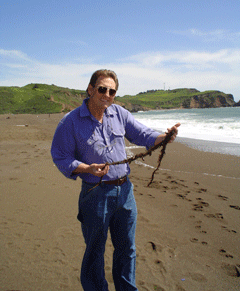
Entrepreneur Jay Harman looks to nature to inspire his inventions. On a beach near the Golden Gate Bridge he studies a strand of kelp for ideas. (Photo: Andrea Kissack)
GELLERMAN: It’s Living on Earth. I’m Bruce Gellerman. Spiders can spin silk stronger than steel. And there are plants that harness the sun’s energy better than a solar cell can. These are examples of evolutionary R & D. Over billions of years, nature has evolved, producing extraordinary technical accomplishments. Increasingly, biologists, engineers, even architects, are imitating mother nature. They call the method “biomimicry.” Andrea Kissick from member station KQED has our story.
[SURF]
KISSICK: Growing up snorkeling off the coral reefs of Australia, Jay Harman has never strayed far from his childhood. As a boy, he paid close attention to how the waves curled and crashed and the sinewy way the fish swam. It all seemed effortless to Harman, who now runs an appliance design company in Marin County, California. As he strolls along a beach just north of the Golden Gate Bridge, Harman is reminded of his earliest inspiration -- seaweed, and the way it moves with the force of water.
[SURF]
HARMAN: You know you get waves out here that are 40-feet high, massive waves, massive amounts of energy. And this kelp doesn't break off. What they are doing in order to survive against this onslaught of this massive mountain of water is they change their shape and they start to spiral into the same spirals that the waves do.

Entrepreneur Jay Harman looks to nature to inspire his inventions. On a beach near the Golden Gate Bridge he studies a strand of kelp for ideas. (Photo: Andrea Kissack)
HARMAN: Nature always follows a particular pathway when it moves. I am talking about how liquids flow, and air flows and how the fog moves and how blood flows in our veins how a seashell grows or the cochlear of the ear grows. All of these things, without exception, have one path of movement, one geometric path of movement, and it’s a spiraling shape.
KISSICK: Think of that sucking sound when the last of the water drains out of the sink
[SOUND OF A WHIRLPOOL]
KISSICK: Harman figured out how to copy a spiraling whirlpool to make more energy efficient, quieter fans, stints, pumps and turbines. He hopes his tiny propellers will be used to curb the spread of disease in developing countries. Harman is part of a movement of innovators inspired by nature and if they were to have a guru, it would be Janine Benyus. In 1997 she coined the term, “Biomimicry” in her seminal book about nature and design. Based in Montana, she travels the globe talking about the idea, to industry, academics, and anyone who will listen.
BENYUS: Around the world right now there are people in design, engineering, architects, chemists, all who are sort of looking over nature’s shoulder, and saying, “how has life already solved the problems that I’m trying to solve?” And they are looking at those strategies and then actually taking the next step and trying to emulate them to solve human problems.”
KISSICK: Like droughts in Africa. Engineers are looking at the Namibian beetle. It turns out its wing scales harvest water even from fog. As the fog rolls in, the beetle lifts its wings and large droplets of moisture build up and run down its shell into its mouth. A German company has developed a self-cleaning paint based on the water repellant lotus leaf. And perhaps the best-known example of biomimicry in action is Velcro, which was inspired by those little prickly things that stick to a dog's tail.
BENYUS: All of those strategies have to be conducive to life. There are not toxic ones, there are not wasteful, you know, overbuilt ones because natural selection’s a really powerful optimizing process.
FULL: The caution that we have is that if you take biomimicry too far and you consider it as blind copying, then you can actually be lead down the wrong path with respect to design.
KISSICK: UC Berkeley Integrative Biology Professor Robert Full is studying the locomotion of bugs and reptiles for ways to inspire robotics.
FULL: It turns out nature works on a satisfying principle. That is, evolution works on a just-good-enough principle, not an optimizing, perfecting principle. And in many cases it’s very hard to tell which parts of the organisms you should mimic and which parts you shouldn’t.
KISSICK: It’s trial and error and a little bit of luck. Nike, who hired a biologist for advice on design, had to pull its Goat-Tek trail shoe, modeled after a mountain goat's hoof, when people didn’t buy them. And that’s where Full, who’s talked with the company, says corporations and manufacturers need to be careful - it may be that some of nature is just not meant to be copied.
FULL: So here’s a gecko. And it’s sticking on a wall in one of their cages.
KISSICK: In his lab in the Life Sciences building on the Berkeley campus, Full points to a Crested Indonesian gecko glommed on to the side of a small aquarium.
FULL: You notice that the feet are a bit unusual in the sense that they are not just kind of flat smooth toes. If you look at them you’ll see that there are sort of ridges there. There are leaf-like structures called lemeli and on those lemeli what we discovered is the Geckos have millions of hairs. If you look at the ends of those hairs, they have the worst case of split ends possible, and that’s the secret of how they can stick on walls and go anywhere.
KISSICK: Full and his colleagues are trying to design a robot, modeled after the Gecko that can scurry up walls and look for victims in burning buildings.
And that seems to be the common thread among most scientists looking to nature for ideas: They are seeking sustainable solutions that will help people and the planet resolve some of today’s most pressing problems. Full just started a new center at UC Berkeley dedicated to teaching the next generation of scientists how to take their cues from nature.
For Living on Earth, I’m Andrea Kissick
Related links:
- Jay Harman’s company, PAX Scientific
- Janine Benyus’ organization: Biomimicry Guild
- Robert Full’s new center at U.C. Berkeley: Center for Integrative Biomechanics in Education and Research (CIBER)
Just Say No to Cerulean Warbler
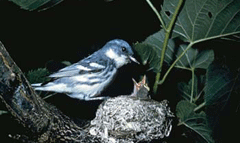
The Cerulean Warbler is four inches long and has a thin, pointed bill. (Courtesy of U.S. Fish and Wildlife Service)
[WARBLER SINGING]
GELLERMAN: The song of the Cerulean Warbler was once common in the forests of the eastern United States. But today the voice of the Warbler is rare. The population of the songbird has declined more than 80 percent in just four decades. And conservationists say this is the reason:
[SOUND OF HEAVY EQUIPMENT AT A MINE]
GELLERMAN: On this mountaintop in West Virginia, huge machines mine coal. This type of excavation has destroyed more than 800 square miles of southern Appalachian forest, which happens to be the heart of the habitat of the migrating Cerulean Warbler.
As the number of birds has steadily and steeply declined, conservation organizations have tried to get the U.S. Fish and Wildlife Service to add the Cerulean Warbler to the Endangered Species list.
The federal government stalled for six years, so the groups sued the Wildlife Service for an answer. Now they’ve got one, and environmentalists don’t like it. The Cerulean Warbler will not be listed as an endangered species. Greg Butcher is Director of Bird Conservation at the National Audubon Society, and he joins us.
BUTCHER: Thanks for having me.
GELLERMAN: Did the decision surprise you?
BUTCHER: No, unfortunately it didn’t. This administration has listed the absolute minimum number of species as threatened or endangered as possible. So, we were afraid this would happen.
GELLERMAN: So why is the Cerulean Warbler so important?
BUTCHER: Well, the Cerulean Warbler is important for a variety of reasons. One, is it’s a beautiful bird. It is one of God’s creations. It is valued in and of its own right. But it also provides an economic importance. It is found in eastern deciduous forests where it eats a variety of insects. And it especially eats leaf-eating insects. And so the leafiness, the shade, the air-cleansing ability of the forest is dramatically better because the Cerulean Warbler is here to do its function.
GELLERMAN: Yeah, but unfortunately its habitat is the same place that is home to the open mining industry in the eastern United States.
BUTCHER: Yes, the Cerulean Warbler is in the bull’s eye for a process known as mountain top removal mining. And there’s still a tremendous amount of coal found in the Appalachian Mountains in the eastern United States. And it turns out that Cerulean Warblers need mountaintops for their preferred habitat. And so a tremendous amount of Cerulean Warbler habitat is projected to disappear in the future, due to this mining practice.

The Cerulean Warbler is four inches long and has a thin, pointed bill. (Courtesy of U.S. Fish and Wildlife Service)
GELLERMAN: People are going to hear this and they’re going to say, “bird: my home being heated in the winter.”
BUTCHER: Bird has to stand for the environment as a whole. And the environment is tremendously important to all of us. If we can’t preserve enough habitat for the Cerulean Warbler to thrive then it’s an indication that we’re not preserving the habitat or the air or the water in the way that humans need to survive.
GELLERMAN: Mr. Butcher, I understand that the Cerulean Warbler has become sort of a poster species, an example of how the Bush Administration has been using, or not using, the endangered species act.
BUTCHER: It’s not a complete poster species yet because we haven’t been able to pull back the curtain and understand how the decision was made. We know for other endangered species that the process hasn’t been followed correctly. And so a bird like the Gunnison Sage Grouse, we know that there was a recommendation from the field to list that bird and then a reversal by the political appointees in Washington DC not to list the bird. So in many ways that’s the worst example we’ve seen so far. It does seem very surprising to us that a bird that’s declining at more than 3 percent per year and more than 30 percent every ten years doesn’t qualify for the endangered species list.
GELLERMAN: Well if the decline of the Warbler has been so dramatic, what reasons did they give for not listing it?
BUTCHER: Well, basically they said that it’s reasonable to assume that we’ll loose 90 percent of the individuals of the species over the next 100 years, but it’s not reasonable to assume we’ll loose them all.
GELLERMAN: You save 10 out of 100 and that’s good enough.
BUTCHER: That’s the reasoning. It’s not good enough for me, and I think it’s not good enough for most people who care about our environment and our bird populations.
GELLERMAN: Well, what are you going to do about it?
BUTCHER: I don’t know for sure yet. It’s one of these things where there’s a long ruling of many pages and we’re going to want to look very carefully at the reasoning. The good thing is that good conservation work for the bird will continue. It’s a very high priority for a wide number of people. Unfortunately we won’t have the same ability to impact the actions of the mining companies as we would have if the bird had been listed.
GELLERMAN: So, if an animal like the Warbler isn’t going to be listed, what hope is there for other animals?
BUTCHER: Well, the hope is that 2 years from now there will be a new administration and that administration is almost certain to care more about the endangered species and the Endangered Species Act than this one does.
GELLERMAN: Have you ever seen a Cerulean Warbler?
BUTCHER: Oh absolutely. It’s a beautiful bird. It’s actually a little tough to see because it nests in the canopies of trees. It sings its heart out, especially during May and June. And so I’ve been out to Shenandoah National Park in the mountains of Virginia and you can hear that song of the Cerulean Warbler and you have to look up and you get a thing called “warbler neck” because you have to look straight up into the canopy to try and find the bird. You can be sure I stuck around until I got a really good look at it.
GELLERMAN: Well, Mr. Butcher, thank you very much.
BUTCHER: Thank you for having me. I’ve enjoyed it a lot.
GELLERMAN: Greg Butcher is Director of Bird Conservation at the National Audubon Society.
Related links:
- U.S. Fish and Wildlife Service “12-month Finding on a Petition to List the Cerulean Warbler (Dendroica cerulea) as Threatened with Critical Habitat”
- National Audubon Society on the Cerulean Warbler
- U.S. Geological Survey on the Cerulean Warbler
Winged Rats or Wronged Warriors?
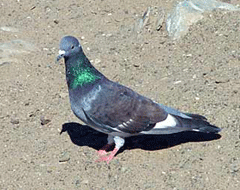
Courtesy of National Parks Service
GELLERMAN: When I say pigeon I bet I can guess what you’re thinking. Pigeons are dirty, right? Disease-carrying pests, a real public nuisance. Well, you’re probably not a person with a passion for pigeons…a person like Andrew Blechman, for example. He’s written a book about the bird titled “Pigeons: The Fascinating Saga of the World’s Most Revered and Reviled Bird” and he joins me. Thank you very much, Andrew.
BLECHMAN: Good to be here.
GELLERMAN: It really is a fascinating saga. Who would have thought that the pigeon had such an amazing history?
BLECHMAN: Well, certainly not me. I’ve tripped into this by accident and the more I learned about this bird the more I was amazed.
GELLERMAN: Well you could say it was a real accident.
BLECHMAN: Yeah, it was actually. I was at the bodega - I used to live in Manhattan - I was getting a tuna sandwich. This place made it just the way I liked it, and while I was there I met a guy named Jose and he tells me that he races pigeons and he got my attention. I didn’t know that people did that, let alone still did that. And he told me that his pigeons were thoroughbreds. That really caught my attention.
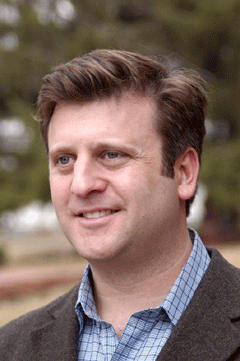
Andrew Blechman is author of “Pigeons: The Fascinating Saga of the World's Most Revered and Reviled Bird” (Photo: Holy Rockwell)
BLECHMAN: Absolutely, in fact the very best pigeons they can bring in a pot of a million dollars at an international race. Actually they’re sold at auction for tens of thousands of dollars. And they’re studded out for several thousand dollars a go.
GELLERMAN: They’re related to doves.
BLECHMAN: Yeah, actually they are. They’re called the rock dove. In fact pigeon is just basically French for “dove.” Just like “paloma” is Spanish for pigeon or dove.
GELLERMAN: Do all pigeons home?
BLECHMAN: Yes, all rock doves do. Some do it better than others who practice. I mean the homing pigeons are thoroughbreds but they all do home. They used to be cliff dwellers. Think of the Cliffs of Dover. They would basically nest in the cliffs and they would forge inland for food. And they would never abandon the nest. And when they mate they mate for life so they would always come back with their food. They basically honed that skill to find their way back.
GELLERMAN: Do we know why they home? How it works?
BLECHMAN: You know it’s funny you should ask. I talked to the very top people in the field including a gentleman at Cornell who dedicated his life to this and no one’s entirely sure. But there are a lot of theories out there and they do have an idea how it goes. Actually they are able to sense a magnetic field around the earth. They’re also able to know where they are using the sun, and the moon, and the stars basically. And the other thing is they have ultrasound hearing so they can gauge where they are. They can hear wind over the Rockies from 2,000 miles away, and gauge where they are by that as well.
GELLERMAN: Well they have extraordinary endurance and speed.
BLECHMAN: Yeah, they routinely will fly 600-mile races at more than 60 miles an hour.
GELLERMAN: You write about pigeons playing a role, an important role, in the Battle of Waterloo.

(Courtesy of National Parks Service)
GELLERMAN: They have an illustrious history. I didn’t realize there were more pigeons honored as heroes in World War One and Two than canines.
BLECHMAN: Yeah, when you look at a pigeon in the park you wouldn’t think that guy’s related to war heroes but they are. In fact, they’re decorated metal war heroes. One million pigeons served in World War One and Two and literally saved thousands of soldier’s lives.
GELLERMAN: They would use them and put little bands around their legs with messages.
BLECHMAN: Yeah, they would ferry critical messages from one place back to headquarters. And they invariably made it back, and quickly. Now think about this too: the first Olympics in 776 BC, the news of the results of the winners was actually sent out to all of the villages by pigeons.
GELLERMAN: Charles Darwin, you write, didn’t get the inspiration for the theory of natural selection from finches, but from pigeons.
BLECHMAN: You know, it’s interesting. We always talk about the finches when we think of Darwin, but that was very early on. That’s when he first got some inklings of what was going on. But it was actually pigeons that he used. He was a pigeon fancier and he would breed them in his back yard.
GELLERMAN: So, you have so many people that love pigeons, but they get such a bad rap. You could say they were, and I’m going to make a bad joke, pigeon-holed.
BLECHMAN: Yeah, they are pigeonholed. And it’s a critical issue. This is an absolutely horribly persecuted bird. The put caustic gels on perches, which burn through its feet. It’s poisoned routinely, electrocuted. And it’s actually a phenomenal animal.
GELLERMAN: Well, Tom Lehrer once wrote about poisoning pigeons in the park with cyanide-coated peanuts.
BLECHMAN: Yeah, somewhere it became funny to persecute pigeons. I’m not really sure where that came. I was always told that to pick on someone smaller than you just wasn’t particularly cool.
GELLERMAN: Well, could it be Woody Allen in Stardust Memories, he called them what, rats...
BLECHMAN: Rats with wings, yeah. It’s believed he invented the phrase “rats with wings.” But they’re really not. In fact, they’re no dirtier than we are. They live off what we drop.
GELLERMAN: Well, what about what they drop? Isn’t that like, really bad for us?
BLECHMAN: No, it’s really no different than what we drop. The problem is that they don’t have toilets. And the problem really is that there’s too many of them. If we had fewer pigeons it wouldn’t be a bigger problem. But then again, you know, wildlife can be inconvenient.
GELLERMAN: Especially urban wildlife. They’re one of the last real vestiges of urban wildlife.
BLECHMAN: And that’s why we really need to appreciate them. I found, when I lived in New York City, that they really animate the place.
GELLERMAN: Andrew, what is your suggestion? What do we do with pigeons to solve the problem?
BLECHMAN: You know humane pigeon control really isn’t that difficult. It’s very simple, really, and they do it all through Germany, Switzerland, and the BENOLUX countries, you know the Netherlands and Holland. And what you do is you create pigeon coops. They’re really just hen houses. And you put them in public areas. And they can be quite beautiful; you can have contests for designing them. And you ask people to feed the birds there and that’s were they will breed.
And at the end of each week you just cultivate the eggs, you just remove the eggs. And you can reduce the pigeon population by half in a matter of a year or two. You know it’s interesting, for 10,000 years pigeons were considered our very best friends. And just in about the last 50 years they’ve been utterly vilified as vermin by the pest control industry. And it’s a very recent, recent thing. I’m just really hoping that people will take another look at this bird because it is just everywhere we are. Everyone can relate to pigeons.
GELLERMAN: Well, Andrew you sound like a real “philoperisteron”. Is that the word?
BLECHMAN: (laughs) That is the word for it. That would be an admirer of pigeons. And I’d have to say yeah, I have become an admirer of pigeons. I can’t look at a pigeon the same way again and I don’t think after reading the book anyone else can as well. I’ve really come to admire these birds.
GELLERMAN: Well, Andrew thank you very much.
BLECHMAN: Thank you for having me.
GELLERMAN: Andrew Blechman is author of “Pigeons: the Fascinating Saga of the World’s Most Revered and Reviled Bird”.
Related links:
- Author Andrew Blechman’s website
- Pigeon Control Advisory Service International
- American Racing Pigeon Union
[MUSIC: Mac & Katie Kissoon “Pigeon” from ‘Pop Masters: Mac & Katie Kissoon’ (Digital Musicworks International - 2005)]
GELLERMAN: Just ahead: when an inventor’s dream turns into a nightmare. Keep listening to Living on Earth.
[MUSIC: Hans Otte & Cecilia Chailly “Wassermannmusik (Aquarian Music) 1” from ‘Hans Otte: Aquarian Music - Seibengesang’ (Amiata Records - 1995)]
Inventor Interrupted
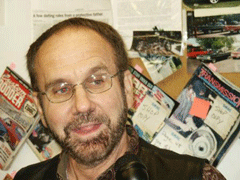
Corliss Orville Burandt (Photo: © Harry Goldstein)
GELLERMAN: It’s Living on Earth. I’m Bruce Gellerman. Some people revel in their work, while others struggle just to show up each day. Some prosper in their careers while others end up broken-spirited and bankrupt. IEEE Spectrum’s Harry Goldstein met a man who loved his work and invented a way to make a better car, but took a wrong turn on the road to success.
[CAR DOOR SLAMS, AIR BLOWING FROM HEATER; “Ah, the heater”]
GOLDSTEIN: You’ve never heard of Corliss Orville Burandt. I hadn’t either, until someone slapped a ten page fax down on my desk that Burandt – or Cob, as he calls himself – sent me about the flood of hybrid electric cars onto the world market.
Cob claimed to have invented and patented a way of using a sensor inside a cylinder of a car engine to optimize how air and fuel mix during combustion. He claims almost all hybrid cars on the market are using a version of his invention. But Cob didn’t get rich off his patent. Instead, he lost his house, his wife, and his mind.
[MUSIC: Radiohead “A Wolf At The Door” from ‘Hail To The Thief’ (Capitol – 2003)]
GOLDSTEIN: Somehow, through years of homelessness, Cob and some well-meaning friends have preserved a prototype of his invention. It sits in the trunk of a sky blue 1965 Corvair in an auto shop in the Minneapolis suburb of Ham Lake. My friend Jon Zurn drove me out there to meet Cob and see the Corvair. The day was blindingly bright and frigid.
[RADIO WEATHER REPORT]
GOLDSTEIN: I explained to John that Cob’s story serves as a warning to all inventors who exchange rights to their patents in return for venture capital to bring those inventions to market. Cob thought he was on his way to easy street when, in 2002, he discovered that Honda’s Intelligent VTec engine used technology similar to that described in his U.S. Patent number 4961406. Issued on October 9, 1990, this patent covers a, quote, “Method and Device for optimizing the air/fuel mixture burn rate of internal combustion engines.”

Corliss Orville Burandt (Photo: © Harry Goldstein)
GOLDSTEIN: So you know Cob’s, did you get Cob’s name?
ZURN: Corliss Orville Burandt.
GOLDSTEIN: Corliss Orville Burandt. Apparently a direct descendant of –
ZURN: Mr. Corliss?
GOLDSTEIN: [Laughs] Mr. Corliss. Some very famous steam engine inventor.
ZURN: He made it efficient.
GOLDSTEIN: He made it efficient. And that’s what we want to do today.
[MUSIC: Idaho "Levitate, Part 2" from ‘Levitate’ (Idaho Music – 2001)]
GOLDSTEIN: With this patent in hand, Cob thought he could force the world’s largest carmakers to pay him royalties on an idea he believed they were clearly using. But there was a problem. A big one. Cob didn’t own the patent.
Not only that, the company to which Cob had assigned ownership, Investment Rarities Inc. of Minneapolis, had failed to pay the U.S. Patent office the maintenance fees due on all 12 of the patents Burandt had garnered over the course of a decade. So, Cob’s invention slipped into the public domain. Today, anyone can use it for free.
By the time I finished telling John the particulars, we had arrived at our destination, Bendsten’s Transmission Center.
[CAR DOOR SLAMS, CRUNCHING THROUGH SNOW]
GOLDSTEIN: Wow, there’re a lot of trucks around here. Don’t see anyone here. Hi! I’m here to see Cob.
GOLDSTEIN: We entered a cramped wood-paneled office and were greeted by the office manager, who fetched Cob from the garage.
BURANDT: Harry?
GOLDSTEIN & ZURN: Hi. How you doing?
BURANDT: Hi. John, pleased to meet you.
GOLDSTEIN: Well groomed, dressed in a black leather vest and black jeans, with piercing grey eyes that would occasionally flutter shut as if he were about to fall asleep, Cob greeted us with a hearty handshake. And immediately launched into his story. His dream was to have car engines communicate with satellites that would calibrate the engine to operate at optimum efficiency depending on where you were driving in the U.S.
[MUSIC: Tom Vek "Cover" from ‘We have Sound’ (Star Time – 2005)]
GOLDSTEIN: What kind of car is it again?
BURANDT: A 1965 Corvair. Or I should say, half of a 1965 Corvair. So we cut the engine in half, and we rotated it 90 degrees, and we made an opposed push rod six cylinder into an upright three-cylinder overhead cam engine with variable compression, variable cam phasing, and variable valve vents that all can be adjusted by radio control. Because we were trying to advocate that you could reprogram things on the fly or from satellites before there were satellites. We were hitchhiking and we were going to do it off of a radio station.
[MUSIC: Secret Chiefs 3 "Welcome To The Theatron Animatronique’ from ‘Book Of Horizons’ (Mimicry - 2004)]
GOLDSTEIN: As a noisy printer churned out page after page of invoices, we stood there in the office listening to Cob, trying to get him to focus on the timeline: when he invented what, and how his whole odyssey began.
GOLDSTEIN: And what years were you showing this around?
BURANDT: Early 80’s.
GOLDSTEIN: Early 80’s. And when you say “we” who was involved in that?
BURANDT: Well, at that time we had so much money we had several professional people that would transport the car. We were dealing with presidents of companies and it was a high roller adventure. We were eating in these restaurants with Muhammad Ali and all these, you know—it was quite the roll. I was there to stay on top of technology. I wasn’t there to be worried about hotel rooms, transportation, or anything. The company said, you think variable valve timing from when you get up and you go to bed, and everything else is on us ‘cause that’s the only way we were going to get to the top.
[MUSIC UP AND UNDER]
GOLDSTEIN: Here was a man who believed his invention could change the world for the better: cheaper, cleaner cars, a better environment, less dependence on foreign oil. The world was his oyster. He was eating in fine restaurants, talking with top executives at big automakers, and he was turning down multimillion dollar offers to develop engines for the likes of GM. All because his venture capitalist, Investment Rarities, thought it could get more.
But when its core business, gold trading, went south in the late 1980s, Investment Rarities dropped Cob and his patents. Cob recalled the grim day in 1988 when he stood between the local post office and a McDonald’s trying to decide whether to spend the only money he had left on a cheeseburger for his growling stomach, or postage for his last remaining patent.
[MUSIC: Idaho "Scrawny" from ‘Levitate’ (Idaho Music – 2001)]
BURANDT: Everybody, I mean everybody, said, walk away from it. Give it up; you’ve wasted your life over it. I said, no way, this is the control patent. Anybody who ever lands one of these mamas has got Easy Street for the rest of his life. And that’s how the…in the end, the financial…it wasn’t believable. I couldn’t tell you a story that would actually...you couldn’t put it in words how horrible the financial end of the deal was. And I rode it through and then basically nothing happened for years. Investment Rarities—basically the IRS shut them down.
GOLDSTEIN: Cob’s eyes fluttered again, and it looked as though he might break into tears at any moment. The nostalgia for what he had, and what might have been, seemed too much. He had made a huge mistake somewhere along the line, and he knew just what it was.
BURANDT: The dilemma that I got myself in is a dilemma that any engineer in the world can get it. I lost everything I owned. I lived in that car. I mean, that was my address. That’s how far I went down the tube. And there was no money to pay maintenance fees. So the Unites States government took away all 12 of my patents. Basically, I started having some stress related health problems. I’m certified crazy! I’m on SSI. Totally mentally disabled. I mean, I was declared crazy. It says right on my papers: “Obsessive compulsive behavior associated with engine patents.” It says it right on my papers, right on the deal when they went down and analyzed me.
GOLDSTEIN: Wow. Wow. Wow!
[MUSIC: The Shins “Young Pilgrims” from ‘Chutes Too Narrow’ (Sub Pop – 2003)]
BURANDT: I mean, I lost everything. I lost my house, I lost all my cars. I lost everything. I was fricking homeless. I lived in that goddamn car for awhile. I mean, how many inventors live in their prototypes? I mean, is that ridiculous or what? It was just…I ruined my family with the deal. But in terms of what happened to me: basically, I was left to rot for eight years.
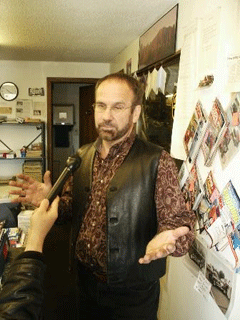
Corliss Orville Burandt (Photo: © Harry Goldstein)
GOLDSTEIN: The annals of technology are filled with stories about inventors whose epic struggles over their inventions drove them over the edge. Some, like Edwin Armstrong, inventor of FM radio, take their own lives. Others, like Nikola Tesla, the father of alternating current, suffered - like Cob - from obsessive compulsive disorder. Tesla required any repeated actions in his life, such as the footsteps he took in a walk, to be divisible by three, and would keep repeating them until he arrived at the right total.
When we met with Cob, it was apparent that his obsessive-compulsions focused entirely on car engines. But beyond that, it seemed to me that some essential part of him, what some people might call a soul, I guess, was indistinguishable from his invention. He is the variable valve mechanism, and it is him. When after over an hour of conversation I asked to see the prototype, his sleepy, medicated eyes sparkled to life, and like a kid on Christmas morning, he bounded through the door leading to the garage and showed us the modified Corvair.
[MUSIC: Texas Red “Car Trouble’ from ‘Nothin’ Can Save Me Now’ (Cold Wind Records – 2004)]
[CAR ENGINE TURNING OVER]
BURANDT: Okay, now this is in economy mode, and you can listen, when we go into performance mode, you will see the idle quality deteriorate. Just to simulate that, I’ll show you what happens here if we push it all the way up.

Cob’s prototype engine. (Photo: © Harry Goldstein)
BURANDT: Maintenance fees are a capitalist tool for driving small people out of business. And the small guy, in my opinion, is always the guy that gets his five years a hit. That’s what we’re buying—that’s what the patent deal does. The sooner we get something birthed and into the incubation period, the greater the potential to capitalize on the large-scale employment we can derive from it. So we need the guys birthing and we need to keep ‘em alive. Well, how the hell are you gonna do that? How could a state do that and get a return on their money? I think making the payment of maintenance fees and possibly the patent application costs, eligible for tax credits—probably another thing I would say on that is, I think especially things that have to do with the environment and energy. That have a social value, not just another hoola hoop but things that have a social value also.
GOLDSTEIN: All right. Well, I think we need to be getting on.
[ON THE ROAD]
GOLDSTEIN: As we drove back to Minneapolis, John and I talked about how it was appropriate somehow that we hadn’t met Cob anywhere but the garage. The garage was where Cob really lived, even when his body was sleeping somewhere else. He tries to solve the same problem over and over again: how to get control of his patents back, and that’s as far as he’ll go because what lies beyond - patent battles with some of the world’s largest corporations - is too remote a possibility even for Cob to contemplate. And surely too expensive for him to ever afford. His patents expire next year, and hope with them. And hope is the only thing that’s kept Cob’s motor running all these years.
[MUSIC: The Album Leaf “Moss Mountain” from ‘In A Safe Place’ (Sub Pop – 2004)]
GOLDSTEIN: As the frozen expanse of Great White North suburbia flashed by, the trailer parks cheek by jowl with the giant malls filled with last minute shoppers, part of me wished I’d asked Cob how he was going to spend Christmas. Another part of me couldn’t bear to know. For Living on Earth, I’m Harry Goldstein.
GELLERMAN: Harry Goldstein is a reporter for Spectrum Radio, the broadcast edition of eye–triple E --- “Spectrum” magazine. To see photos of Corliss Orville Burandt – a.ka. “COB” – and his invention - visit our website - Living on Earth dot org.
Related link:
IEEE Spectrum Radio
Season of Light
Coming up on Living on Earth: the days have grown short, the nights dark and cold.It’s time to gather by the fireside for our annual holiday storytelling special. At this time of year, we celebrate light because in many parts of the world, there isn’t very much of it.
DAHLSVEEN: The winter in Norway is dark and I’m so lucky to live in a place in Norway where there is a few hours of light in daytime, but up north in Norway it’s dark, daytime, night time.
GELLERMAN: Heidi Dahlsveen tells stories: stories that shine with hope, even on the darkest of days. But beware what might be lurking in the depths of a Norwegian winter night.
DAHLSVEEN: It was Christmas Eve. It was cold. It was a dark dark time. He could hear the sound of small waves. He felt the strong salty smell. He walked on the pier towards the boat. He jumped into the boat, filled the keg. He even took a sip himself and the strong liquid warmed him even out to his fingertips. And he had just stepped out of the boat when he heard a sound. SSSSSLLLLUUURP. And he slowly looked up and when he saw what he saw he was petrified. He looked straight at the sailors and the fishermen’s greatest fear, death itself.
Draugen was standing in front of him, blocking his way. Draugen; once he was a brave fisherman or a sailor, too brave and headstrong with no respect for the ocean. He tried to conquer the ocean and was himself conquered by it. And because he had been so headstrong and headless he was now missing the head. Instead of the head it was sea tangle and seaweed on top of his shoulders. And the young man he ran as fast as he could. He heard him coming closer and closer and soon he reached a churchyard but in that moment he heard the bell going dong dong dong 12 times in the middle of the most dark night of Norway and he thought, “I wonder if I will survive this darkness…”
GELLERMAN: Join us for the Living on Earth holiday special, “Season of Light. “ We’ll celebrate with tales of light and darkness, from around the world. And we promise, they won’t all be scary.
[MUSIC: Hege Rimestad “Yearning Home” from ‘White Arrow’ (Northside – 1997)]
GELLERMAN: We leave you this week half way around the world to catch up, once again, with the humble pigeon:
[PIGEONS ON A SILL]
GELLERMAN: By Northern India’s Lake Pichola, rock doves roost on a windowsill at water's edge. Women wash laundry nearby, striking clothes against the stone embankments, as calls to prayer echo in the distance. Living on Earth’s Dennis Foley captured the scene by the water in the city of Udaipur.
[EARTH EAR: Lake Pichola Waterside” recorded by Dennis Foley in Udaipur, Rajasthan, India (October 10th, 2006)]
GELLERMAN: Living on Earth is produced by the World Media Foundation.
Our crew includes Ashley Ahearn, Eileen Bolinsky, Tobin Hack, Ingrid Lobet, Emily Taylor and Jeff Young - with help from Bobby Bascomb, and Kelley Cronin.
Our interns are Ian Gray and Jennifer Percy. Dennis Foley is our technical director. Our executive producer is Steve Curwood. Alison Lirish Dean composed our themes. You can find us at loe dot org. I’m Bruce Gellerman. Thanks for listening.
ANNOUNCER: Funding for Living on Earth comes from the National Science Foundation, supporting coverage of emerging science; And Stonyfield Farm organic yogurt, smoothies and milk. Ten percent of profits are donated to efforts that help protect and restore the earth. Details at Stonyfield dot com. Support also comes from you our listeners, the Ford Foundation, the Town Creek Foundation, and the Saunders Hotel Group of Boston's Lennox and Copley Square Hotels. Serving you and the environment while helping preserve the past and protect the future, 800-225-7676.
ANNOUNCER 2: This is PRI. Public Radio International
Living on Earth wants to hear from you!
Living on Earth
62 Calef Highway, Suite 212
Lee, NH 03861
Telephone: 617-287-4121
E-mail: comments@loe.org
Newsletter [Click here]
Donate to Living on Earth!
Living on Earth is an independent media program and relies entirely on contributions from listeners and institutions supporting public service. Please donate now to preserve an independent environmental voice.
NewsletterLiving on Earth offers a weekly delivery of the show's rundown to your mailbox. Sign up for our newsletter today!
 Sailors For The Sea: Be the change you want to sea.
Sailors For The Sea: Be the change you want to sea.
 The Grantham Foundation for the Protection of the Environment: Committed to protecting and improving the health of the global environment.
The Grantham Foundation for the Protection of the Environment: Committed to protecting and improving the health of the global environment.
 Contribute to Living on Earth and receive, as our gift to you, an archival print of one of Mark Seth Lender's extraordinary wildlife photographs. Follow the link to see Mark's current collection of photographs.
Contribute to Living on Earth and receive, as our gift to you, an archival print of one of Mark Seth Lender's extraordinary wildlife photographs. Follow the link to see Mark's current collection of photographs.
 Buy a signed copy of Mark Seth Lender's book Smeagull the Seagull & support Living on Earth
Buy a signed copy of Mark Seth Lender's book Smeagull the Seagull & support Living on Earth

